
Humans have long pushed the boundaries of what is possible. We want longer bridges in harsher environments, impenetrable military equipment and lighter aircraft that take us farther with less fuel.
These feats will require experts in structural mechanics, material design, superalloys, colloid engineering, corrosion protection and adhesives; and URI engineers have just the expertise and equipment needed to advance our understanding in these fields and leverage that knowledge into everyday products that exist in extreme conditions.
People are just now discovering all the benefits of these materials in terms of cost savings and their performance in extreme environments. Our research is helping to advance the field.
“Design under routine conditions, that has been done,” Mechanical Engineering Professor Arun Shukla says. “This is new.”
Using shock tubes, a 2,000-gallon underwater pressure tank, and high-speed cameras, Shukla’s team literally blows things up to learn how to keep them together. Armed with the results, Shukla and his colleagues have written the book on how materials will act under extreme temperatures, pH, heat transfer rates and pressure.
Other engineers at URI are exploring the effect of extreme environments on carbon composite materials by looking at them, literally, at the molecular level using our College of Engineering’s scanning electron microscope and chemical engineering labs.
Chemical Engineering Professor Richard Brown says providing insights into understanding how to prevent new materials from corroding in such environments as salt water is required. With that understanding, researchers have turned to developing new surface treatments for metals to improve how adhesives bond composite materials such as carbon fiber and prevent degradation, and to combat processes such as intergranular corrosion of aluminum alloys.
“We’re not just developing the adhesive but a complete system that improves the durability of the bond,” Brown says.
The demand for such a system is booming. Because composite materials are usually lighter but just as strong as traditional metals, engineers are using them in aircraft, ships, automobiles, wind turbines and even cell phones. Less weight typically means better fuel efficiency and less material required, thus reducing costs. Plus the materials tend to have a higher tolerance for damage and are easier to maintain.
“People are just now discovering all the benefits of these materials in terms of cost savings and their performance in extreme environments,” Shukla says. “Our research is helping to advance the field.”
